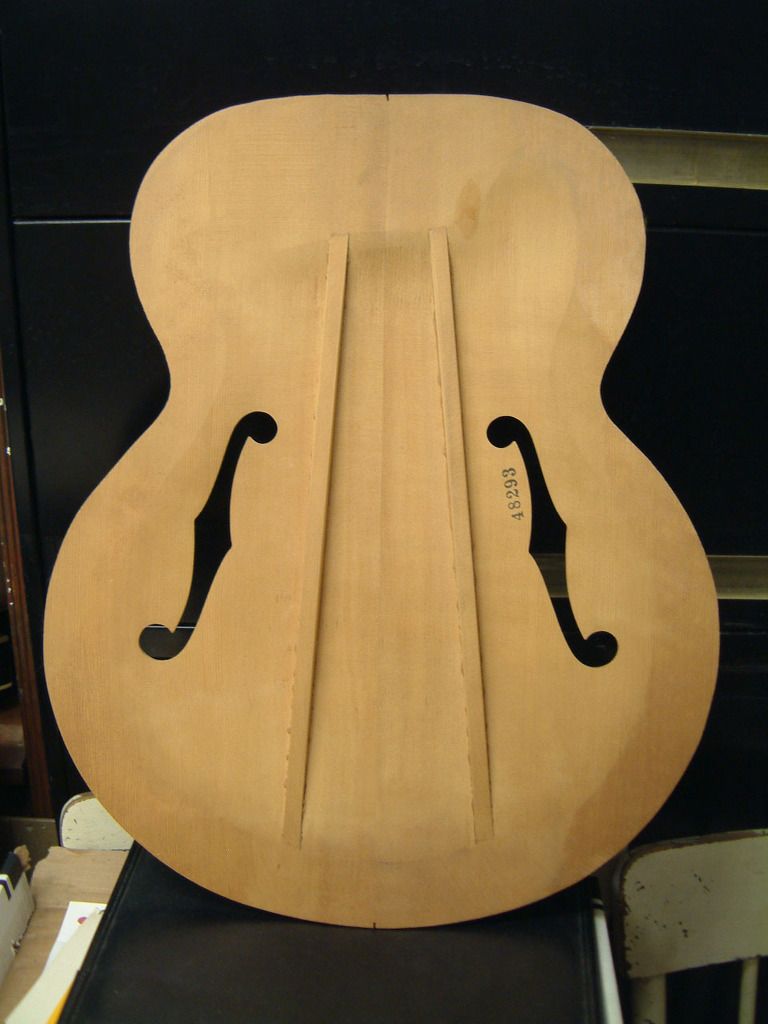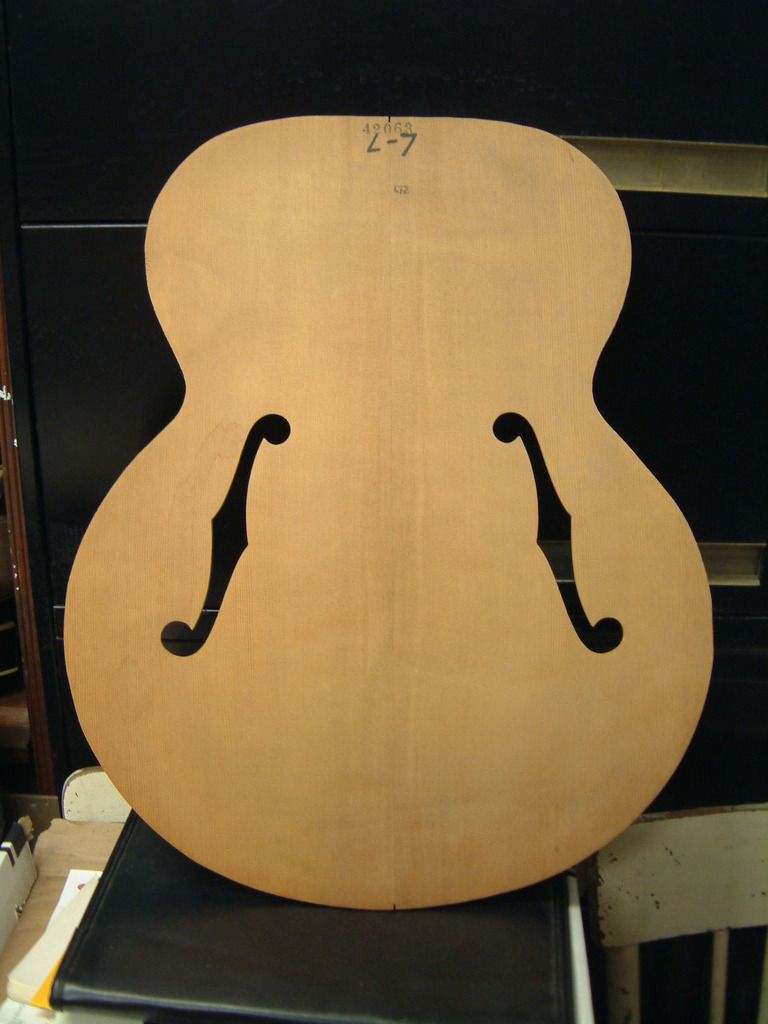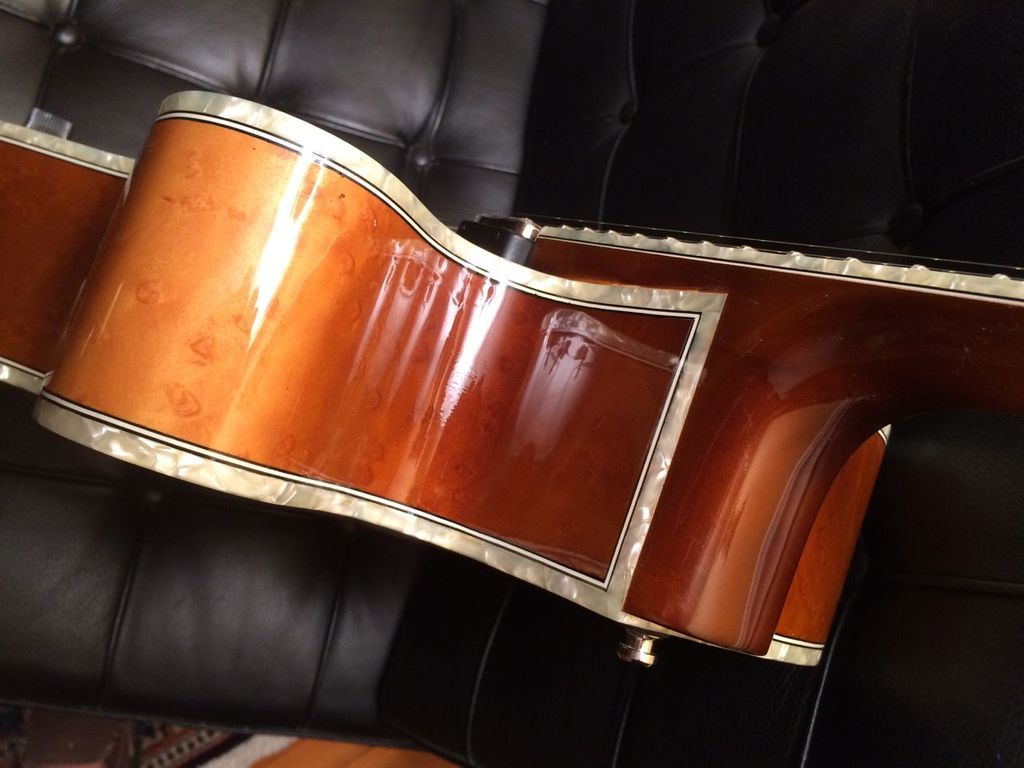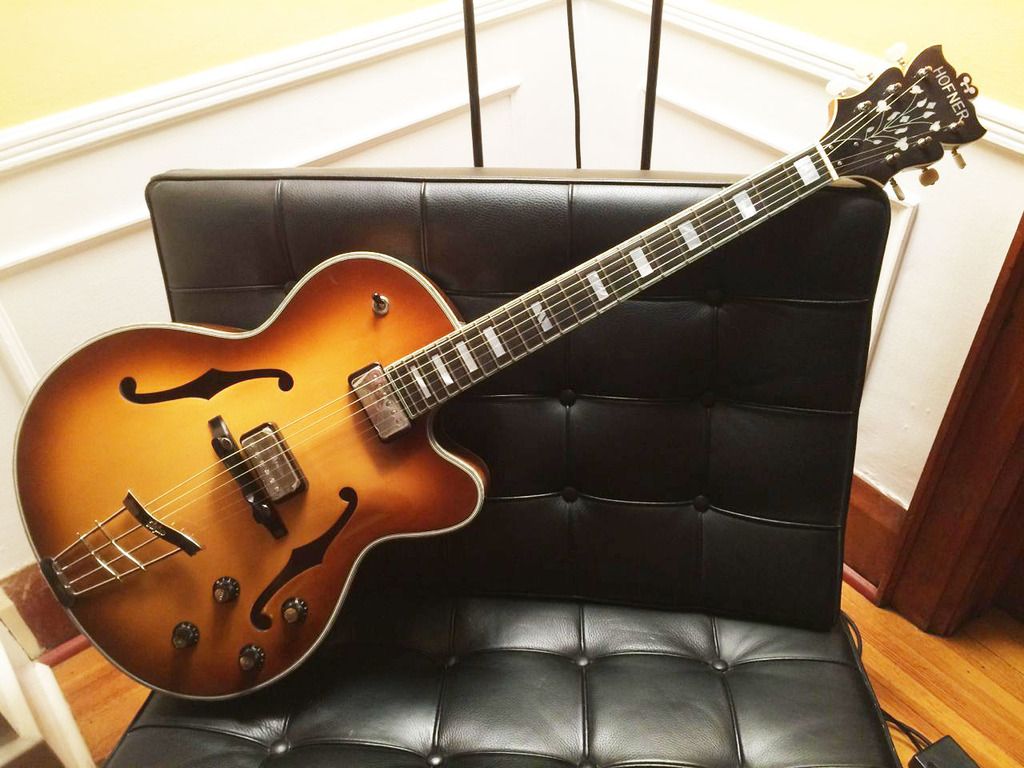-
I’m sure this has been covered before, but when you type in “Gibson” + “binding” into the forum search engine, you tend to get a lot of hits. Anyway, here’s my query - I’ve noticed on some models of the Gibson L-7C that the binding in the cutaway area seems to get wider; however, in other models, such as my 1952, the binding remains the same width all along the guitar, cutaway area included. I’ve included a few pics. The first is from a 1968 L-7C that I saw online. The second is a pic of my ’52 L-7C. So, my question is: what’s up with that?

Thanks.
-Travis
SaveSave
-
06-08-2017 10:08 PM
-
It has to do with how the top is carved. I asked Bob Benedetto about this when I was building my first archtop and wanted to find out where to get the wide binding - he told me he carved the edges of the tops so the binding would be the same width all the way around the guitar. I think the tops of the older guitars with cutaways started out as full tops so when they put in the cut, they had to cover that edge with something. From your pics, it appears that some were built the more modern way.
-
According to Benedetto's video series on making an archtop, he states that the modern way is the correct way. He stated when you carve the top, you carve it as a cutaway and not a non cutaway instrument. The top responds a lot better the modern way.
-
Modern way? Carving the top to follow the cutaway was introduced by Gibson in 1939 on the L-5P guitar, before Bob was born. It was used for years before Gibson gave it up. Guild also used it and it was the centre of the argument Johnny Smith had with them about how to build his eponymous model. Virtually all German carved archtop cutaway guitars built between 1947 and 1967 are carved to follow the cutaway as well. It's as old as the cutaway archtop.
-
Maybe it's bias on my part, but I prefer the look of the consistent width binding.
-
What's odd is I prefer the wider binding in the cutaway like on my L5ces. I can't say why, maybe because it's not uniform it whispers "hand made, hand made, one of a kind" even though I know that's not actually true.
 Originally Posted by Socraticaster
Originally Posted by Socraticaster
-
A symmetrically carved top is significantly easier to make than blending the carve for the cutaway.
Having done both, I can say that if I was being called to produce them in large numbers it would be very tempting to carve it as a non cutaway and literally cut away at the top to conform to the sides.
Of course this is speculation on my part, but I think the tall binding is a concession to the needs of factory production. I don't like the look. I suspect in part because I consider it a time/labor saving device not something done for the sake of the instrument or player. But it doesn't seem to have a noticeable effect on the tone, and many people seem to like it. So why not?
Sent from my iPhone using Tapatalk
-
I'd imagine that Gibson starts out with a wide strip of binding to cover the hole exposed when the top is cut away and simply scrapes away the rest of it around the guitar. That is a lot of scraping and a lot of plastic.
Cutting and graduating the top and back as a cutaway from the outset makes more sense to me. I prefer the uniform width binding, too.
-
never really cared either way, but I don't spend much time actually looking @ my guitars.
-
I like the Gibson cutaway archtops that sound best. If they have the fat binding, I can live with that. I would prefer the thin, but it comes down to sound.
Ultimately, you have to play the guitar and decide. Some of the best L-5 instruments I have played had rather plain maple sides and backs, but they sounded GREAT. Other things equal, I'd have preferred them to be highly figured.
You just don't know until you start strumming.
-
Les Pauls with natural sides have a thin binding with the maple top peeking out, no problem for me. This is my GTLP "Custom Classic" of which technically it is neither... marketeers, sheesh.
-
I had a 39 L5P and it wasn't carved into the cutaway. I remember Bob on the tape saying the recurve needs to be carried into the cutaway for the center to vibrate correctly. I'm no expert, just repeating what I read.
 Originally Posted by Hammertone
Originally Posted by Hammertone
-
My '69 Johnny Smith had the wider binding in the cutaway. I never really thought about it much construction wise, but when I was cleaning her up once in a while I thought it looked cool. Made the rim look straight, yet arched at the same time. Kind of a dichotomy.
-
Yes of course, all Johnny Smiths look like that, because that's how John DAngelico did it. First carve the top plate as if it were a non-cut, and then make the cutaway, thus necessitating the wider binding in that area. And the JS model was specified to be a direct copy of Smith's favorite DA Excel
 Originally Posted by Woody Sound
Originally Posted by Woody Sound
Johnny Smith broke off his initial endorsement with Guild because they refused to do it that way, they made the cutout first and then did the carving.
Jimmy Daquisto later commented that either way was fine, with no noticeable influence on sound. DAngelico just did it, because he was too lazy making new body molds When his production shifted from noncuts to majorily cutaway guitars, he just placed an insert in his existing noncut mold and kept on using it.
When his production shifted from noncuts to majorily cutaway guitars, he just placed an insert in his existing noncut mold and kept on using it.
-
Like the ES 350, the faded Tal prototype and reissues don't have the thick binding while the original Tals and Kessels from the '60s do...
Maybe it was to give those laminated top instruments the same carve appeal ?
-
I find a certain sexiness in the oversized binding in the cutaway.
I like curves.
JD
-
I'm with Joe D. I think that variation in the binding is curvaceous and sexy!
-
So when, exactly, did Gibson make the switch from uniform binding to wide binding? Or, more accurately, when did Gibson stop using a separate plate to carve cutaways?
-
Gibson introduced the Premier cutaway in 1939. They did not alter their rough-carving jigs to do this. Instead of simply sawing out the cutaway area and using wider binding within the cutaway, they hand-carved the top at the cutaway to get the perimeter edge within the cutaway to be even with the rest of the rimset. This allowed them to use uniform-thickness binding around the entire plate. This is what defines a P-style cutaway. P-style guitars often exhibit very crude carving at their cutaways.
Current examples of this can be seen on Andersen archtops - he has taken this approach and refined it to a very elegant carve within the cutaway areas of his archtops. Gibson also designed an elegant version of this, for the re-issue Bozeman L-7C made between 2003 and @2012.
The P-style guitars were replaced by C-style guitars (L-5P vs L-5C, for example) @1948. C-style cutaways simply have the cutaway area sawn off from a non-cutaway plate without any other carving, requiring deeper binding within the cutaway area, that follows the arch of the top.
Here's a original old Gibson factory replacement carved 17" plate. Note that it can be carved to fit the rims of either an L-7P, L-7C or L-12P. Or an L-5P | L-5C, for that matter - just add f-hole binding:


Last edited by Hammertone; 04-04-2020 at 10:29 PM.
-
-
Ya know, I gots to git me a Hofner one of these days. I like the President Custom.
very nice..
Joe D
-
-
Oh, the one with the Artichoke/Mouseketeer headstock..
-
My L-7C from 1952 has uniform binding. Actually, all the L-7C's currently selling on Reverb from the 50s have uniform binding through the cutaway. Did you perhaps confuse the description of P-style with C-style?
 Originally Posted by Hammertone
Originally Posted by Hammertone
SaveSave
-
Not at all. I simply don't think Gibson cared at all about it. These instruments were produced in a factory environment. Plates got used, regardless of the style of carve. Lots of Gibson labels don't even have the model name stamped on them. Lots of L-7 and L-7C guitars have laminated backs; whether that was on purpose or by accident I have no idea. There are all sort of variations. It's all covered by the "specifications may change without notice" CYA statement that is printed into all the catalogue literature. I view the designation merely as a general point of reference, not as a critical DNA sequence. I use the terms "P-style carve" or "C-style carve" as useful shorthand. I don't think Gibson put much thought into it, and I suspect they changed the name simply to get away from the word "Premier"
 Originally Posted by Socraticaster
Originally Posted by Socraticaster
Here is a recent Bozeman L-7C with what I'd call a P-style cutaway carve, compared to a Heritage SE with what I'd call a C-style carve:Last edited by Hammertone; 04-04-2020 at 10:11 AM.




 Reply With Quote
Reply With Quote









Part 2 Secrets to McCoy Tyner using 4ths,...
Today, 07:31 PM in Improvisation